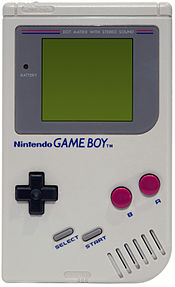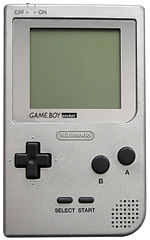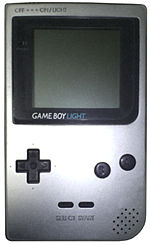- Game Boy
-
For the entire Game Boy line of handheld consoles, see Game Boy line.
Game Boy 

Manufacturer Nintendo Product family Game Boy line Generation Fourth generation Retail availability Units sold Worldwide: 118.69 million, including Game Boy Pocket and Color units Media Game Boy cartridges. Best-selling game Tetris, 30.26 million (pack-in/separately)
Pokémon Red and Blue, 23.64 million approximately (as of January 18, 2009).[3]Predecessor Game & Watch Successor Game Boy Pocket (redesign)
Game Boy Light (second redesign)
Game Boy Color (successor)The Game Boy (ゲームボーイ Gēmu Bōi), is an 8-bit handheld video game device developed and manufactured by Nintendo. It was released in Japan on April 21, 1989, in North America in August 1989, and in Europe on September 28, 1990. It is the first handheld console in the Game Boy line, and was created by Gunpei Yokoi and Nintendo Research & Development 1—the same staff who had designed the Game & Watch series as well as several popular games for the Nintendo Entertainment System.[4]
The Game Boy is Nintendo's second handheld system following the Game & Watch series introduced in 1980, and it combined features from both the Nintendo Entertainment System and Game & Watch and its B&W (except for Konami/Factor 5 games and Seaquest DSV shown in color).[4] It was originally bundled with the puzzle game Tetris.[5]
Despite many other, technologically superior handheld consoles introduced during its lifetime,[6] the Game Boy was a tremendous success. The Game Boy and Game Boy Color combined have sold 118.69 million units worldwide. Upon its release in the United States, it sold its entire shipment of one million units within weeks.[7]
Contents
Features
The Game Boy has four operation buttons labeled "A", "B", "SELECT", and "START", as well as a directional pad.[8] There is a volume control dial on the right side of the console and a similar knob on the left side to adjust the contrast.[9] At the top of the Game Boy, a sliding on-off switch and the slot for the Game Boy cartridges are located.[10] Nintendo recommends users to leave a cartridge in the slot to prevent dust and dirt from entering the system.[11]
The Game Boy also contains optional input and/or output connectors. On the left side of the system is an external power supply jack that allows users to use an external rechargeable battery pack or AC adapter (sold separately) instead of four AA batteries.[12] The Game Boy requires 6 V DC of at least 150 mA.[13] A 3.5 mm stereo headphone jack is located on the bottom side of the console which allows users to listen to the audio with headphones or speakers.[14]
On the right side is a port that allows a user to connect to another Game Boy system via a link cable, provided both users are playing the same game.[15] The port can also be used to connect a Game Boy Printer. The link cable was originally designed for players to play head-to-head two-player games such as in Tetris. However, game developer Satoshi Tajiri would later use the link cable technology as a method of communication and networking in the popular Pokémon video game series.[16]
Design and release
- Alleyway
- Baseball
- Super Mario Land
- Tennis
- Tetris (Bundled with Game Boy)
European launch titles
Reception
The Game Boy and Game Boy Color combined have sold 118.69 million units worldwide, with 32.47 million units in Japan, 44.06 million in the Americas, and 42.16 million in other regions. By Japanese fiscal year 1997, before Game Boy Color's release in late-1998, the Game Boy alone had sold 64.42 million units worldwide.[17][18]
At the time of its release in 1989, the Atari Lynx was also just being introduced to the market. This system featured color graphics, a backlit screen, and networking capabilities.[19] However, its release price of $189.95 and substantial requirement of 6 AA batteries that would provide roughly only four or five hours of gameplay (compared to 10–12 hours on 4 AA batteries and a release price of $89.99 for the Game Boy) doomed it to a second-rate status.[20] Nintendo also experienced heavy competition from Sega's Game Gear. To promote its new color console, Sega aired a number of negative ad campaigns in the United States that mocked the Game Boy's monochrome display compared to Game Gear's full color display. Like the Lynx, it too required six AA batteries that only lasted about 4–6 hours and was much more expensive than the Game Boy.[21] The Game Gear had the advantage of being fully compatible (with an adapter) with all Sega Master System games and, while not as successful as the Game Boy, it sold from 1991 until early 1997,[22] and sold around 11 million units in total.
In 2009, the Game Boy was inducted into the National Toy Hall of Fame, 20 years after its introduction.[23]
As of June 6, 2011, Game Boy and Game Boy Color games are available on the Virtual Console service on the Nintendo 3DS's Nintendo eShop.[24]
Other models
Play It Loud!
On January 1, 1995, Nintendo released several Game Boy models with colored cases, advertising them in the "Play It Loud!" campaign.[25] Specifications for this unit remain exactly the same as the original Game Boy, including the monochromatic screen. This new line of colored Game Boys would set a precedent for later Nintendo handhelds; the Game Boy Pocket, the Game Boy Color, Game Boy Advance (including the SP and Micro), Nintendo DS (including the Lite, DSi, DSi XL), and Nintendo 3DS all feature different colored units. Play It Loud! units were manufactured in red, green, black, yellow, blue, white, and clear (transparent) cases. A very rare, limited edition Manchester United Game Boy is red, with the logos of the team emblazoned on it was released simultaneously with the Play it Loud! handhelds in the United Kingdom. The Play It Loud's screens also have a darker border than the normal Game Boy (with the exception of the black Play it Loud!).
Game Boy Pocket
In 1996, Nintendo released the Game Boy Pocket: a smaller, lighter unit that requires fewer batteries. It has space for two AAA batteries, which provide about 10 hours of game play. The Pocket has a smaller link port, which requires an adapter to link with the older Game Boy. The port design is used on all subsequent Game Boy models, excluding the Game Boy Micro. The screen was changed to a true black-and-white display, rather than the "pea soup" monochromatic display of the original Game Boy. Also Game Boy Pocket (GBP) has a larger screen than the Game Boy Color (GBC) that later superseded it, the GBP's screen is 65mm (2.56") diagonal, width 48.5mm (1.91"), height 43.5mm (1.71") compared to a 59mm (2.32") diagonal for the GBC. Again, and like the Game Boy, the Game Boy Pocket has no backlight to allow play in a darkened area. The first version did not have an LED to show battery levels. This was soon added due to public demand, along with new Game Boy Pocket units of different colors, some of them new to the Game Boy line. There were several limited-edition Game Boy Pockets including a metallic Ice Blue unit and a pink model exclusive to Japan. The Game Boy Pocket was not a new software platform and played the same software as the original Game Boy model.
Game Boy Light
The Game Boy Light was released on April 14, 1998 for ¥6,800[26] and was only available in Japan. The Game Boy Light is only slightly bigger than the Game Boy Pocket and features an Electroluminescent backlight for low-light conditions. It uses 2 AA batteries, which gave it approximately 20 hours with the light off and 12 with it on. It was available in two standard colors; Gold and Silver, as well as numerous special editions. There is an Astro Boy edition with a clear case with an Astro Boy picture on it. There is a Osamu Tezuka World shop edition with a clear red case and a picture of his characters. There is a Pokémon Center Tokyo version in yellow color. There is a clear 'skeleton' Famitsu edition which had only 5,000 units released. There is a clear yellow edition separate from the solid yellow Pokémon Center Tokyo version.
It was the only handheld Nintendo produced with an integrated backlight until the release of the Nintendo DS in 2004 (The Game Boy Advance SP released in 2003 was frontlit, and the later backlit model Game Boy Advance SP (Model AGS-101) was not released until 2005)
Technical specifications
- CPU: Custom 8-bit Sharp LR35902[27] core at 4.19 MHz which is similar to an Intel 8080 in that all of the registers introduced in the Z80 are not present. However, some of the Z80's instruction set enhancements over the stock 8080, particularly bit manipulation, are present. Still other instructions are unique to this particular flavor of Z80 CPU. The core also contains integrated sound generation.[28]
- RAM: 8 kB internal S-RAM[29] (can be extended up to 32 kB)[30]
- Video RAM: 8 kB internal[30]
- ROM: On-CPU-Die 256-byte bootstrap;[31] 256 kb, 512 kb, 1 Mb, 2 Mb, 4 Mb and 8 Mb cartridges
- Sound: 2 square wave generators, 1 PCM 4-bit wave sample (64 4-bit samples played in 1x64 bank or 2x32 bank) channel , 1 noise generator, and one audio input from the cartridge.[32] The unit only has one speaker, but headphones provide stereo sound (for further information, see Game Boy music)
- Display: Reflective STN LCD[33] 160 × 144 pixels[30]
- Frame Rate: Approx. 59.7 frames per second on a regular Game Boy, 61.1 on a Super Game Boy[34]
- Vertical Blank Rate: Approx 1.1ms[34]
- Screen size: 66 mm (2.6 in) diagonal[28]
- Color Palette: 2-bit (4 shades of "gray" {light to very dark olive green})[30]
- Communication: Up to 2 Game Boys can be linked together via built-in serial ports, up to 4 with a DMG-07 4-player adapter.[30]
- Power: 6 V, 0.7 W (4 AA batteries provide ~15 hours)[33]
- Dimensions: 90 mm (W) x 148 mm (H) x 32 mm (D) / 3.5" x 5.8" 1.3" [33]
See also
- List of Game Boy colors and styles
- List of games for the original Game Boy
- List of Game Boy accessories (list of all known accessories)
- Game Boy accessories (description of some selected accessories)
- Game Boy Advance
- Game Boy line
- Microvision, the first handheld to use cartridges
References
- ^ "retrodiary: 1 April – 28 April". Retro Gamer (Bournemouth: Imagine Publishing) (88): 17. April 2011. ISSN 1742-3155. OCLC 489477015.
- ^ White, Dave (July 1989). "Gameboy Club". Electronic Gaming Monthly (3): 68.
- ^ "ELSPA Sales Awards: Platinum". Entertainment and Leisure Software Publishers Association. Archived from the original on 2009-05-15. http://web.archive.org/web/20090515224703/http://www.elspa.com/?i=3944. Retrieved 2009-01-18.
- ^ a b Beuscher, Dave. "allgame ((( Game Boy > Overview )))". Allgame. http://www.allgame.com/platform.php?id=20. Retrieved 2008-09-11. "A team headed by Gumpei Yokoi designed the Game Boy. Yokoi had previously designed hand held games for Nintendo with the cartridge based Game & Watch system, introduced in 1980. His staff, called Research and Development (R and D) team #1, had designed the successful NES games Metroid and Kid Icarus. What Yokoi's team did was create a hybrid of the NES and the Game & Watch systems.."
- ^ McFerran, Damien. "The Making of Gameboy". Issue. Retro Gamer Magazine. pp. 42–47. http://www.meanmachinesmag.co.uk/upload/media/scans/retrogamergameboy.pdf. Retrieved 2011-01-30.
- ^ "AtariAge - Lynx History". AtariAge. http://www.atariage.com/Lynx/history.html. Retrieved 2010-08-23. "Released in 1989, the Lynx offered multi-player functionality, 3D graphic capabilities, reversible controls, and a backlit color LCD screen."
- ^ Kent 2001, p. 416. "According to an article in Time magazine, the one million Game Boys sent to the United States in 1989 met only half the demand for the product. That allotment sold out in a matter of weeks and it's black and white (expect for Konami/Factor 5 games and SeaQuest DSV,, was shown in color like the Game Gear version."
- ^ Owner's Manual, p. 5. "(12) Operation buttons — The controls for playing games. (See game manuals for button functions.)"
- ^ Owner's Manual, pp. 4–5. "(5) Volume dial (VOL) — Adjusts the sound volume…(7)Contrast adjustment (CONTRAST) — Adjusts the contrast of the display."
- ^ Owner's Manual, pp. 3–4. "(3) Game Pak slot — Insert the Nintendo GAME BOY Game Pak here. (See page 7 for instructions on inserting Game Pak)"
- ^ Owner's Manual, p. 10. "To avoid dust and dirt getting in the Game Boy unit, always leave a Game Pak inserted when not in use."
- ^ Owner's Manual, p. 4. "(2) External power supply jack — You can connect a Rechargeable Battery Pack (sold separately) for longer play."
- ^ "Nintendo Game Boy (DMG-001)". Vidgame.net. 2006. Archived from the original on 2008-02-11. http://web.archive.org/web/20080211181421/http://www.vidgame.net/NINTENDO/GB.html. Retrieved 2006-08-22.
- ^ Owner's Manual, p. 5. "(10) Headphone jack (PHONES) — Connect the stereo headphones that come with the GAME BOY to enjoy the impressive sounds of games without disturbing others around you...."
- ^ Owner's Manual, pp. 4, 8. "(4) Extension connector (EXT CONNECTOR) — Connects to other GAME BOY…Do not insert different games in the interconnected Game Boys."
- ^ Masuyama, Meguro (2002). "Pokémon as Japanese Culture?". In Lucien King. Game On. New York, NY: Universe Publishing. p. 39. ISBN 0-7893-0778-2. "Pokémon allowed more than metaphorical communication; it made use of a system that created actual communication — a network game."
- ^ "Consolidated Sales Transition by Region" (PDF). Nintendo. 2010-01-27. Archived from the original on 2010-02-14. http://www.webcitation.org/5nXieXX2B. Retrieved 2010-02-14.
- ^ "A Brief History of Game Console Warfare: Game Boy". BusinessWeek. McGraw-Hill. http://images.businessweek.com/ss/06/10/game_consoles/source/7.htm. Retrieved 2008-07-30. "Game Boy and Game Boy Color's combined lifetime sales reached 118.7 million worldwide, according to Nintendo's latest annual report."
- ^ "The Atari Lynx". ataritimes.com. 2006. Archived from the original on 2006-08-29. http://web.archive.org/web/20060829165904/http://www.ataritimes.com/lynx/index.html. Retrieved 2006-08-20.
- ^ Beuscher, Dave. "allgame ((( Atari Lynx > Overview )))". Allgame. http://www.allgame.com/platform.php?id=13. Retrieved 2008-09-21. "One drawback to the Lynx system is its power consumption. It requires 6 AA batteries, which allow four to five hours of game play. The Nintendo Game Boy provides close to 35 hours use before new batteries are necessary."
- ^ Bauscher, Dave. "allgame ((( Sega Game Gear > Overview )))". Allgame. http://www.allgame.com/platform.php?id=25. Retrieved 2008-09-21. "While this feature is not included on the Game Boy it does provide a disadvantage—the Game Gear requires 6 AA batteries that only last up to six hours. The Nintendo Game Boy only requires 4 AA batteries and is capable of providing up to 35 hours of play."
- ^ Bauscher, Dave. "allgame ((( Sega Game Gear > Overview )))". Allgame. http://www.allgame.com/platform.php?id=25. Retrieved 2008-09-21. "Eventually, a peripheral called the Master System Converter was released enabling Sega Master System cartridges to be played on Game Gear… The Game Gear sold well for Sega but it did not become a phenomenon like Game Boy. In 1991 Sega sold over 500,000 units. In 1992 Sega sold 900,000 Game Gear consoles."
- ^ "''Ball, Game Boy, Big Wheel enter toy hall of fame'', retrieved 5 Nov 2009". Rbj.net. http://www.rbj.net/article.asp?aID=181826. Retrieved 2010-08-03.
- ^ Reilly, Jim. "GDC: TurboGrafx 16, Game Gear Hit 3DS". IGN/com. http://ds.ign.com/articles/115/1153010p1.html. Retrieved 18 July 2011.
- ^ "Color it loud with hot new Game Boys; Game Boy reflects players own style with five exciting new colors". http://www.allbusiness.com/consumer-products/computing-products-consumer-software/7088694-1.html. Retrieved 2009-11-03.
- ^ "Nintendo Japan Game Boy Light official homepage". http://www.nintendo.co.jp/n02/dmg/hardware/light/index.html. Retrieved 2009-11-03.
- ^ nintendods (2004-09-29). "季節報 Nintendo DS ブログ : 解体新書。初代GBをバラしてみる。 (Game Boy hardware dissection)" (in Japanese). http://nintendods.exblog.jp/381307/. Retrieved 2009-01-02.
- ^ a b DP. "GameBoy CPU Manual". http://marc.rawer.de/Gameboy/Docs/GBCPUman.pdf. Retrieved 3 June 2011.
- ^ Jeff Frohwin. "Gameboy Internals (CPU Section)". http://marc.rawer.de/Gameboy/gameboy1.gif. Retrieved 2011-06-03.
- ^ a b c d e Rawer, Marc. "The Gameboy Project: 1.1 Technical Details". http://marc.rawer.de/Gameboy/docu_1.htm#1.1. Retrieved 3 June 2011.
- ^ GameBoy Development Wiki (2009-11-12). "Gameboy Bootstrap ROM". http://gbdev.gg8.se/wiki/index.php?title=Gameboy_Bootstrap_ROM&oldid=192. Retrieved 2010-10-24.
- ^ "Game Boy - 8bc Chiptune Wiki". 2008-11-05. Archived from the original on 2008-02-21. http://web.archive.org/web/20080221140919/http://8bitcollective.com/wiki/index.php?title=Game_Boy#Sound. Retrieved 2009-03-26.
- ^ a b c Amos, Evan (1989). "GameBoy : User Manual, Page 12". Nintendo of America. http://www.flickr.com/photos/30348074@N00/5439992398/in/set-72157626034398554/. Retrieved 2011-02-12.
- ^ a b Fruttenboel Gameboy Section (2009-08-22). "GameBoy : Using the GameBoy skeleton for serious business (Interrupt Descriptions)". http://verhoeven272.nl/cgi-bin/FSgz?fruttenboel%2FGameboy&Fruttenboel+Gameboy+section&GBtop&GBspec&GBcontent. Retrieved 2010-03-25.
- Game Boy Compact Video Game System Owner's Manual. Nintendo. 1989. DMG-GB-UKV.
- Kent, Steven L. (2001). The Ultimate History of Video Games (1st ed.). Roseville, CA: Prima Publishing. ISBN 0-7615-3643-4.
- Hand-held electronic game - Design patent for the case
External links
- Official website
- Game Boy at Nintendo.com (archived versions at the Internet Archive Wayback Machine)
- Game Boy (original) games list at Nintendo.com (archived from the original at the Internet Archive Wayback Machine)
- Game Boy at the Open Directory Project
- Game_Boy at Nintendopedia.
- Game Boy console games Game boy games search
Handheld game consoles Bandai Entex Game Park/Holdings Nintendo Game & Watch (Mini Classics) · Game Boy (Pocket · Light) · Game Boy Color · Game Boy Advance (SP · Micro · Visteon Dockable Entertainment) · Pokémon mini · Nintendo DS (Lite · DSi · DSi XL) · Nintendo 3DSNokia Sega SNK Sony Other handhelds 1970s1980s1990s2000s2010sCategories:- 1989 introductions
- Game Boy consoles
- Monochrome video game consoles
- Regionless game consoles
- Fourth-generation video game consoles
- National Toy Hall of Fame inductees
- Handheld game consoles
- Z80
Wikimedia Foundation. 2010.




